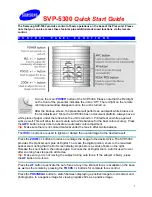
9
resulting image is cleaner. In StarShoot Image Capture, you
can find the current temperature of the chip in the lower right-
hand corner of the screen, next to the current resolution
(Figure
9a)
. Cooler control is located down the list in the left hand win-
dowpane
(Figure 9b)
. Note the current temperature of the cam-
era, then turn the cooler on, set a target temperature, and wait
for the chip to reach that target temp. Please note that the colder
the chip, the more prone to internal dew. The CMOS chamber
has been purged of moisture at the factory, but pushing the
cooler to its limit may still cause whatever moisture remains to
condense on the chip. You’ll notice this in the image as a circular
pattern that grows in the image, and a major loss of detail.
If the chip dews over, raise the target temperature and give the
chip a few minutes to acclimatize. Raising the temp to 0 degrees
C should remove any dew after a few minutes. It’s good to reduce
the temperature of the chip, but it doesn’t have to be all the way
down to 35 degrees below ambient. Somewhere between 15-25
degrees below ambient still provides a great noise reduction,
but with much less chance of the chip dewing over. Once the
target temp is reached and is stable, proceed with taking your
light and dark frames. They must both be at the same expo-
sure length and temperature for the darks to correctly calibrate.
Since the cooler is regulated, you can also use these darks in
subsequent imaging sessions, as long as you keep the target
temperature the same night to night for your light frames. This is
another good reason not to reduce the temperature to its lowest
possible setting. If the next night is warmer, it won’t be possible
to drop the cooler as far from ambient temperature.
Conversion Gain
Along the left hand pane is a window for conversion gain, and
options (if your specific camera supports both options) for LCG
and HCG -- low and high gain. LCG should be used most of
the time, especially when a lower gain setting is used. However,
if you are boosting the gain up high to keep exposures times
lower, try switching to HCG and readjusting gain, which can
reduce read noise in the chip without losing as much dynamic
range in the image. But when in doubt, stay in LCG mode, and
your images will turn out fine. The ASCOM driver also includes
LCG/HCG settings when in 3rd party control programs.
Dark Frames
Dark frames are images taken with no light coming into the
camera. A dark frame is typically taken with the telescope cap
attached. The only data in the image is the inherent camera
noise. The noise contains the dark current (background noise
level), read noise (noise introduced during camera readout and
download) hot pixels (bright dots in the image) and amp glow
(Figure 10)
. All of this noise exists in your raw astro-image too,
which distracts from the detail you want to see. To eliminate
most of the camera noise, you can take several dark frames,
average them together, then subtract this “master dark” from
your “light” astro-images.
Note: Make sure the cooler set point
and camera temperature are the same as they were when
you took your light frames.
Dark frames are handled through
most of the 3rd party control programs listed previously.
Flat Field Frames
Flat Frames are more advanced, and mentioned here as a point
of reference. A flat field is an image taken with uniform feature-
less light entering the telescope, such as a blue sky in the early
morning or after sunset. Flat fields solve a number of issues in
your astroimages:
Vignetting
Vignetting in a telescope reveals edge-darkening in the astro-
image. Vignetting is more apparent when the telescope’s illumi-
nated field is not large enough to illuminate the full area of the
chip. As a result, more light is detected in the center of the image
compared to the edge.
Dust and Particles
Dust and particles will inevitably show up in your raw astro-
images. Large particles on the camera optical window some-
times look like unfocused circles or doughnuts in your images.
It’s too late to clean your camera if you are already imaging in
the field at night. And even when the camera is clean, dust usu-
ally finds a way to show up in your images.
Telescope Artifacts
Very large particles or other artifacts in your telescope can affect
your astro-images. Insufficient telescope baffling or poor colli-
mation can also cause unsymmetrical field illumination in your
images.
To take a flat field image:
1. Ensure that the telescope is focused and ready for astro-
imaging.
2. Point the telescope at a uniform and featureless light
source, like the sky at dusk or dawn, or a blank white
sheet of paper. Make sure the camera orientation
is exactly the same as it is or was for astro-imaging
Figure 10.
A 120 second dark frame, from a G10. Note the amp
glow on the upper right side, this is standard for the ICX294 chip, and
is removed from light images during dark frame subtraction. The G16
will show a different dark frame amp glow signature, and the G26/
G24 have ZERO amp glow!
































